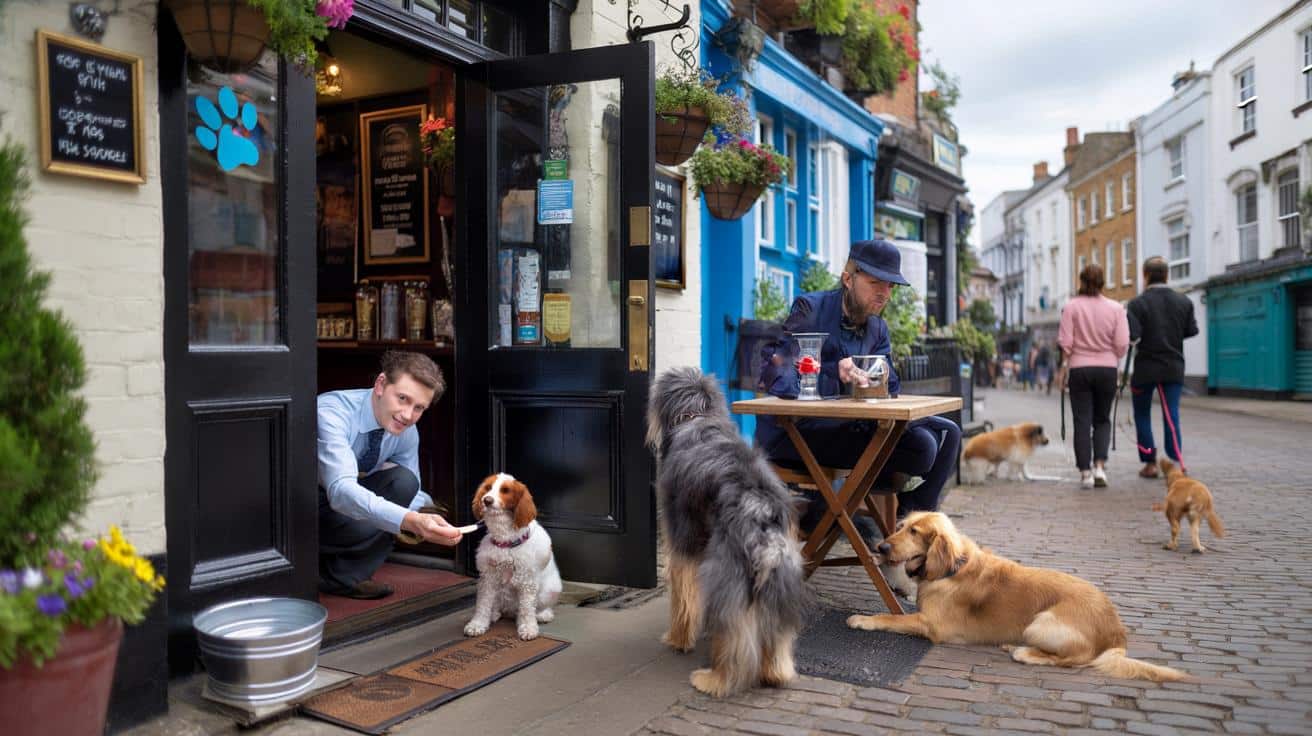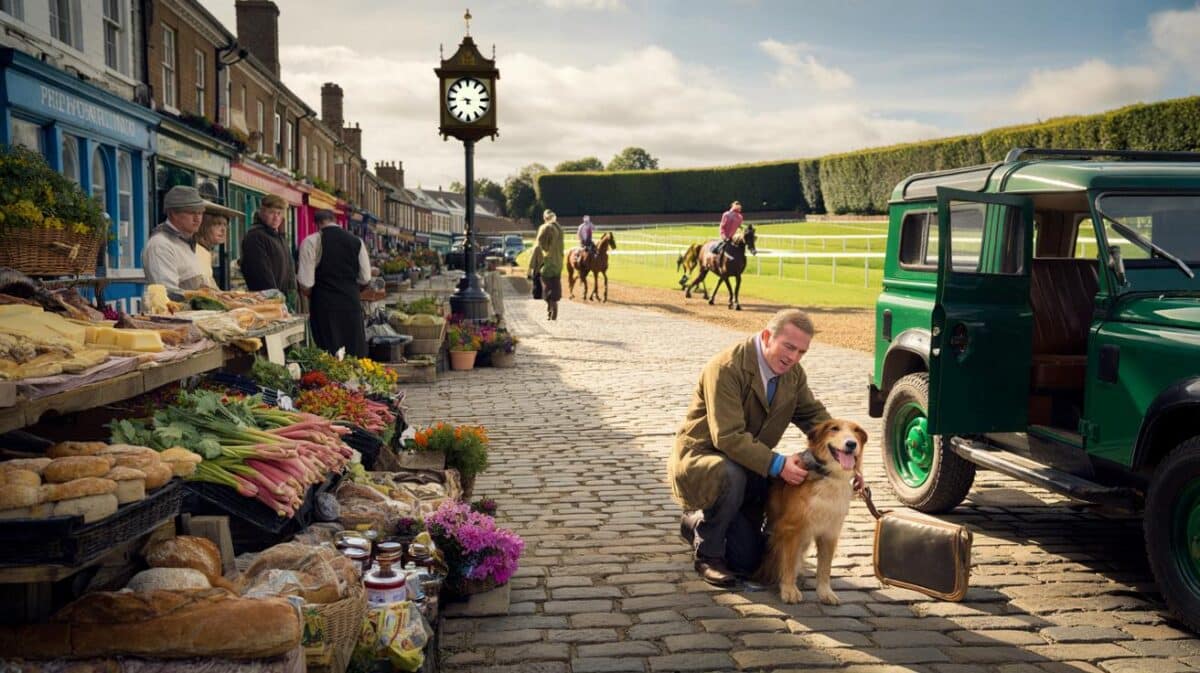A national vote has pushed Bury St Edmunds into the spotlight, and the signs are literally on the doors. A simple Blue Paw window mark now guides owners to venues that welcome four legs as warmly as two. The result is a centre where shopping, lunch and heritage no longer mean leaving a companion in the car.
How the blue paw scheme works
Shops, cafés and attractions that opt in display a bright paw symbol at the entrance. That sticker means the basics are covered. Expect fresh water, a friendly reception and clarity about where to sit or stand with your dog. Staff receive short guidance on leads, layout and busy hours so conversations stay easy.
The blue paw by the door is a promise: water on tap, a treat at the counter and space for paws to settle.
The approach reflects the scale of demand. Britain counts roughly 12.5 million dogs. Those owners plan days around pets and prefer places that remove uncertainty. Bury St Edmunds has turned that preference into a public charter and a shared list of participating venues, so residents and visitors avoid guesswork at the threshold.
From micro pub to soaring nave
Hospitality leads the way. The Nutshell, often billed as Britain’s smallest pub, squeezes character into about 15ft by 7ft and still finds room for dogs. A cluster of stalwarts, including the Dog & Partridge, the Weeping Willow and the Old Cannon Brewery, keeps bowls filled and fusses ready. Staff signal quieter corners for large breeds at peak times.
The welcome runs beyond beer and bar stools. Harriet’s Cafe Tearooms and Café Kottani accommodate well‑behaved pets at tables. Edmundo Lounge keeps it casual with pavement seating and the odd biscuit. Garden‑centre regulars know the setup at Dobbies, where a slower afternoon suits older dogs.
Even St Edmundsbury Cathedral admits dogs, turning a routine walk into a pause beneath medieval stone and the Millennium Tower.
Guided walks now include dog‑friendly editions, which turn heritage into a pace‑matched outing. A lighthearted “dogs of the cathedral” calendar has joined the town diary, signalling that the welcome is more than a sticker.
Rules that make it work
A short charter underpins the scheme. Businesses commit to water access, clear signs and staff briefings. Owners agree to short leads indoors, tidy pavements and a courteous give‑way in tight aisles. That shared baseline keeps the mood calm and the floors clean.
- Spot the Blue Paw mark before you enter; it sets expectations on both sides of the door.
- Ask staff for a spot with room for big dogs during busy service.
- Carry a travel bowl on hot days and between stops.
- Assume leads stay on near counters and buffets.
- Check pet fees and rules when booking rooms, as terms vary.
Where to sit, sip and stay
Town‑centre staples
The heart of the town is compact, which helps short legs. Angel Hill, the cathedral precinct and Abbey Gardens form a triangle of lawns, shade and history. Market days bring bustle and noise, so early arrivals suit nervous dogs. Benches under trees give resting spots between errands.
Pubs and cafés locals back
Regulars point to the Dog & Partridge, the Weeping Willow, the Old Cannon Brewery, The Nutshell, Harriet’s Cafe Tearooms, Café Kottani and Edmundo Lounge. Seasons and staffing can shift arrangements, so confirm at the door. A quick glance at the window mark saves awkwardness.
| Amenity | What you’ll usually get | Typical locations | Guide price |
|---|---|---|---|
| Water bowl | Fresh top‑ups on request | Pubs, cafés, Blue Paw shops | Free |
| Dog treats | Biscuits at the till | Cafés and bars | Free |
| Dog ice cream | Small tubs or cups | Selected cafés and delis | £2–£4 |
| Pet‑friendly rooms | Bed, bowl, welcome pack | Hotels, inns, B&Bs | £10–£25 per night, per dog |
What the title changes on the ground
Traders report later afternoons are busier than last year. Owners no longer cut trips short to dash home for a walk. Extra time adds a coffee between shops, another round at the bar and more confidence to book an overnight stay. Operators now run guided routes that assume dogs will join, which spreads visits beyond weekends.
Residents gain a cleaner, calmer centre. Clear rules reduce frayed tempers at doorways and counters. Visitors gain certainty. One glance at a sticker decides whether to step inside or try next door.
Certainty sells: a visible promise at the door turns a hesitant passer‑by into a paying customer with a lead in hand.
Plan a visit with paws
Trains link Bury St Edmunds with Cambridge and Ipswich. Drivers will find central car parks within a short stroll of Abbey Gardens. Summer Saturdays draw crowds, so start early, aim for shade at lunch and save indoor stops for the hotter hours. A lightweight mat helps your dog settle under café tables. A spare lead is handy near busy crossings.
Think about sound as much as heat. Market clatter can unsettle sensitive dogs. The cathedral close offers a quiet circuit if paws need a pause. The Nutshell’s charm comes in a tiny package; peek in first, then return when the bar thins out.
Health and etiquette, the local way
Test pavements with your hand in warm weather. Short‑haired breeds feel heat fast on dark stone. Offer small sips often rather than one large drink. Ask before any greeting with another dog, even with a wagging tail. Staff know calmer corners, so say if you need space from doorways or prams. Keep treats pocketed unless you have permission to share, as allergies are common.
Why other towns are watching
The model works because it is simple and visible. A shared charter, a sticker and a basic staff note align expectations. Any high street could borrow it with a small training pack and a public list that stays updated. The benefit is tangible: longer dwell times, repeat visits and a standard that encourages responsible ownership.
Here is a quick self‑audit for your own town on a Saturday: count dogs on leads, venues with bowls outside and moments of confusion at shop doors. If confusion outnumbers bowls and leads, a clear scheme like the Blue Paw approach would likely help. Add a handful of dog‑friendly walks and a seasonal photo calendar, and families gain reasons to stay longer and bring friends.
Practical extras make days smoother. Teach a “settle” on a mat at home before your trip; cafés feel easier with a ready cue. Budget for accommodation pet fees of around £10–£25 per dog, per night, and check if breakfast rooms permit dogs or offer a separate lounge. Pack wipes for muddy paws, a clip‑on light for dusk walks and a towel for sudden showers. If you plan to pair town time with a countryside loop, check lead rules near livestock and avoid midday heat on exposed tracks.
For those weighing risks and rewards, the gains are clear. Pets stay with their people, streets feel friendlier and spending spreads through the day. The main risk is avoidable: crowded corners without a plan. In Bury St Edmunds the plan is on the door, in blue, and thousands of tails say it works.








